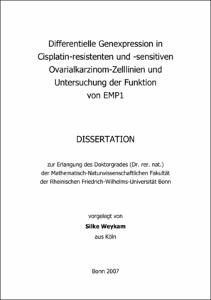Differentielle Genexpression in Cisplatin-resistenten und -sensitiven Ovarialkarzinom-Zelllinien und Untersuchung der Funktion von EMP1

Differentielle Genexpression in Cisplatin-resistenten und -sensitiven Ovarialkarzinom-Zelllinien und Untersuchung der Funktion von EMP1

| dc.contributor.advisor | Kassack, Matthias U. | |
| dc.contributor.author | Weykam, Silke | |
| dc.date.accessioned | 2020-04-12T12:33:25Z | |
| dc.date.available | 2020-04-12T12:33:25Z | |
| dc.date.issued | 2008 | |
| dc.identifier.uri | https://hdl.handle.net/20.500.11811/3575 | |
| dc.description.abstract | Cisplatin wird in der Behandlung einer Vielzahl von Tumoren eingesetzt. Es ist u. a. Bestandteil der „First-Line“-Therapie des Ovarialkarzinoms. Leider ist seine Wirksamkeit durch das Auftreten von Resistenzen limitiert. Die Cisplatin-Resistenz ist seit einiger Zeit schon Gegenstand intensiver Forschungen. Es scheint sich um ein multifaktorielles Geschehen zu handeln, dessen einzelne Mechanismen jedoch noch nicht komplett bekannt sind. In dieser Arbeit wurde die differentielle Genexpression der Cisplatin-sensitiven und –resistenten Ovarialkarzinom-Zelllinien A2780 und A2780cis nach 24stündiger Cisplatin-Inkubation (10 µM; 0,5 h Auswaschphase) untersucht. Mit der Methode der Suppressions-Subtraktions-Hybridisierung (SSH) wurden vier differentiell exprimierte Kandidaten-Gene ermittelt. In einer nachfolgenden qRT-PCR konnte die Überexpression von EMP1 (Faktor 41), PI15 (Faktor 370) und DDX21 (Faktor 8) in der Cisplatin-sensitiven Zelllinie A2780 und die Überexpression von HF1 (Faktor 3) in der Cisplatin-resistenten Zelllinie A2780cis bestätigt werden. Aufgrund der interessanten Zusammenhänge in Hinblick auf Proliferation und Wachstumsfaktor-Rezeptoren wurde das Gen EMP1 (Epitheliales Membranprotein 1) im Folgenden funktionell untersucht. Zunächst wurde das Gen EMP1 in einen Expressionsvektor kloniert. Anschließend konnten EMP1-überexprimierende Klone aus den Zelllinien A2780 und A2780cis etabliert werden (A2780-EMP1 und A2780cis-EMP1). Dies wurde mittels qRT-PCR, Immunoblot-Analyse und ICC auf Genexpressions- und Proteinebene verifiziert. Die EMP1-Klone zeichnen sich durch ein geringeres Zellwachstum innerhalb von 72 h im Vergleich zu ihren jeweiligen parentalen Zelllinien aus. Die beiden EMP1-Klone zeigten in Immunoblot-Analysen eine geringere Expression von p53 und p21 als ihre Ursprungszelllinien A2780 und A2780cis. Außerdem weisen die EMP1-überexprimierenden Zelllinien und die parentale A2780 nur eine sehr geringe bis keine IGF1R-Expression auf Proteinebene auf. Im Gegensatz dazu besitzt die Cisplatin-resistente Zelllinie A2780cis eine starke IGF1R-Expression, sowohl nach Cisplatin Inkubation (über 2 Monate wöchentlich für 4 h 1 – 2 µM) als auch nach einer zweimonatigen Cisplatin-freien Phase. Das interessanteste Ergebnis in dieser Arbeit war die signifikante Steigerung der Sensitivität gegenüber Cisplatin in den EMP1-überexprimierenden Klonen jeweils um den Faktor 2 (MTT-Test/BrdU-Test). In vorhergehenden Studien wurde die EMP1-Expression mit einer Resistenz gegenüber Rezeptortyrosinkinase-Inhibitoren in Zusammenhang gebracht. Die in dieser Arbeit gefundene Sensitivierung gegenüber Cisplatin durch eine EMP1-Überexpression erscheint zunächst in einem Gegensatz dazu. Weitere Untersuchungen zur der Funktion von EMP1 in den Netzwerken der Cisplatin-Resistenz und der RTK-Inhibitoren-Resistenz können hier Aufklärung leisten. Außerdem kann die Aufklärung des Cisplatin-sensitivierenden Effektes von EMP1 zur Entdeckung neuer therapeutischer Targets führen. Vor allem stellt EMP1 einen interessanten Ansatzpunkt für Studien zur Untersuchung von Prädiktivmarkern für ein Ansprechen auf Cisplatin dar. | en |
| dc.description.abstract | Differential gene expression in cisplatin-resistant and -sensitive ovarian cancer cell lines and analysis of the function of EMP1 Ovarian cancer is the most frequent cause of death among the gynaecologic malignancies. The first-line chemotherapeutic treatment of ovarian cancer commonly comprises the use of cisplatin. Unfortunately resistance limits its effectiveness. The phenomenon of cisplatin-resistance is intensively investigated but still not fully understood. In this study we analysed the cisplatin-sensitive and –resistant ovarian carcinoma cell lines A2780 and A2780cis. Suppressive-subtractive hybridisation (SSH) has been used to examine differential gene expression of the two cell lines after incubation with 10 µM cisplatin for 24 h. A set of four candidate genes has finally been confirmed by qRT-PCR to be differentially expressed. The genes EMP1, PI15 and DDX21 are overexpressed in the cisplatin-sensitive cell line A2780 (factor 4, 370 and 8 respectively) and the gene HF1 is overexpressed in the cisplatin-resistant cell line A2780cis (3-fold). In the following, we focused on the gene EMP1, which is associated with cell proliferation, apoptosis and growth factor receptors. EMP1 was cloned and transfected into A2780 and A2780cis cells. Recombinant overexpression was confirmed by qRT-PCR, immunoblotting and ICC. Proliferation of EMP1-clones (A2780-EMP1 and A2780cis-EMP1) is lower after 72 h and they show less p53 and p21 protein expression compared to their parental cell lines. The parental cell line A2780 and both EMP1-clones exhibit only very weak IGF1R expression on protein level, whereas the cisplatin-resistant cell line A2780cis shows strong IGF1R expression. Most strikingly, both A2780-EMP1 and A2780cis-EMP1, exhibit a 2-fold sensitisation against cisplatin (MTT-assay/BrdU-assay). As a conclusion we have identified EMP1 as a differentially expressed gene in the cisplatin-sensitive and -resistant ovarian cancer cell lines A2780 and A2780cis. It has been reported that EMP1 is involved in receptor tyrosin kinase inhibitor-resistance. In this study we show that overexpression of EMP1 in ovarian carcinoma cell lines leads to a 2-fold sensitisation against cisplatin. These results demonstrate that EMP1 is a promising target for further research, particularly with regard to its use as a predictive marker for cisplatin-resistance. | en |
| dc.language.iso | deu | |
| dc.rights | In Copyright | |
| dc.rights.uri | http://rightsstatements.org/vocab/InC/1.0/ | |
| dc.subject | Platinkomplexe | |
| dc.subject | Eierstockkrebs | |
| dc.subject | A2780 | |
| dc.subject | RTK-Inhibitor | |
| dc.subject | Prädiktivmarker | |
| dc.subject.ddc | 500 Naturwissenschaften | |
| dc.subject.ddc | 540 Chemie | |
| dc.subject.ddc | 610 Medizin, Gesundheit | |
| dc.title | Differentielle Genexpression in Cisplatin-resistenten und -sensitiven Ovarialkarzinom-Zelllinien und Untersuchung der Funktion von EMP1 | |
| dc.type | Dissertation oder Habilitation | |
| dc.publisher.name | Universitäts- und Landesbibliothek Bonn | |
| dc.publisher.location | Bonn | |
| dc.rights.accessRights | openAccess | |
| dc.identifier.urn | https://nbn-resolving.org/urn:nbn:de:hbz:5N-13209 | |
| ulbbn.pubtype | Erstveröffentlichung | |
| ulbbnediss.affiliation.name | Rheinische Friedrich-Wilhelms-Universität Bonn | |
| ulbbnediss.affiliation.location | Bonn | |
| ulbbnediss.thesis.level | Dissertation | |
| ulbbnediss.dissID | 1320 | |
| ulbbnediss.date.accepted | 06.12.2007 | |
| ulbbnediss.fakultaet | Mathematisch-Naturwissenschaftliche Fakultät | |
| dc.contributor.coReferee | Wiese, Michael |
Files in this item
This item appears in the following Collection(s)
-
E-Dissertationen (4442)




